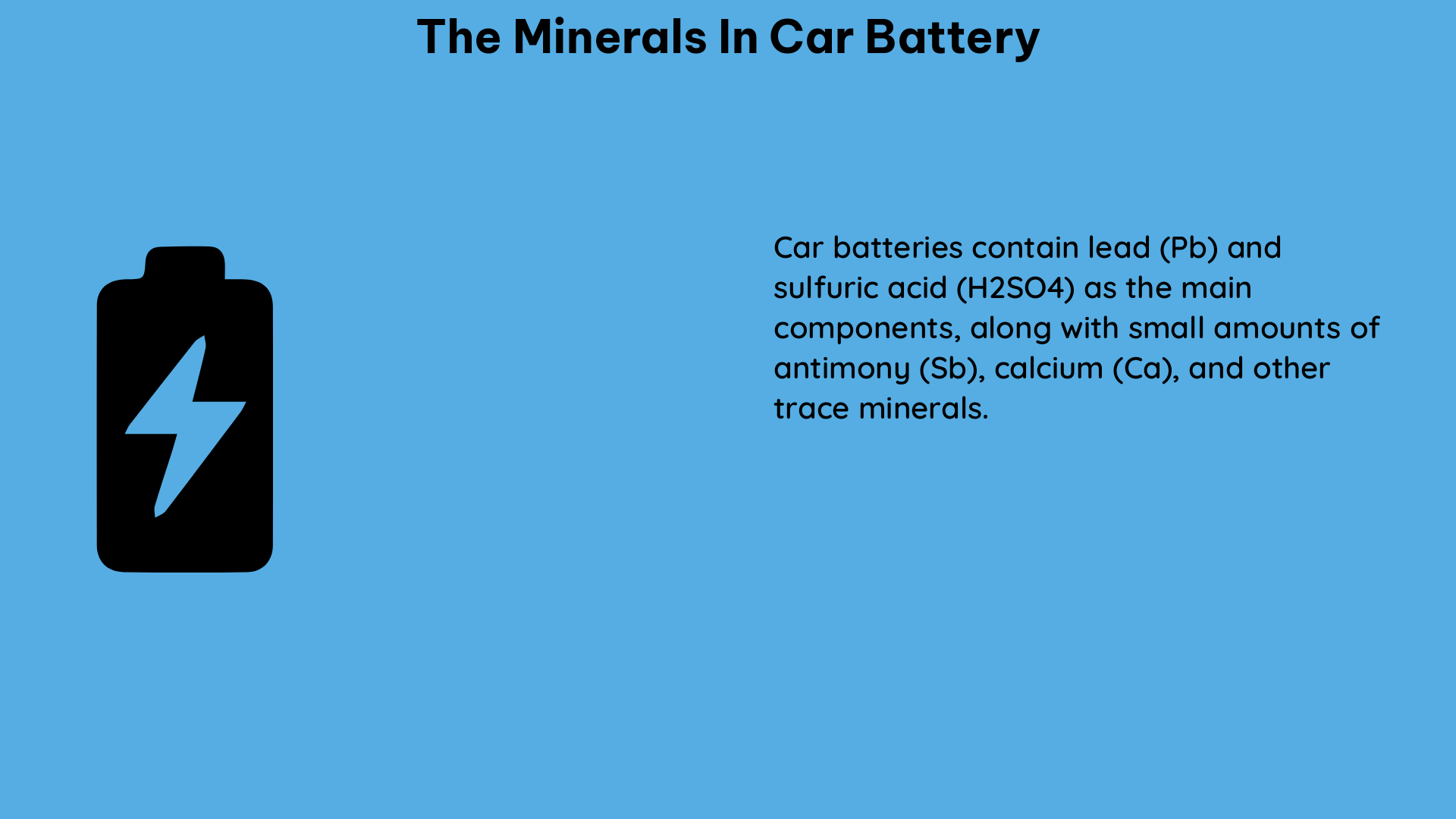The minerals in a car battery primarily include lithium, cobalt, nickel, and manganese. These minerals are essential for the production of lithium-ion batteries, which are the most commonly used batteries in electric vehicles (EVs). The specific quantities of these minerals in a battery can vary depending on the battery chemistry and design, with a single lithium-ion battery pack in an electric car containing around 8 kg of lithium, 35 kg of nickel, 20 kg of manganese, and 14 kg of cobalt.
Lithium: The Cornerstone of Car Batteries
Lithium is the key mineral in lithium-ion batteries, serving as the primary charge carrier. It is estimated that the global lithium demand for electric vehicles will increase from 84,000 metric tons in 2021 to 500,000 metric tons by 2030, driven by the rapid adoption of EVs. The majority of the world’s lithium reserves are located in South America, with Chile, Argentina, and Bolivia accounting for over 75% of the global supply.
Cobalt: The Controversial Mineral

Cobalt is another essential mineral in lithium-ion batteries, playing a crucial role in the battery’s energy density and stability. However, the extraction and processing of cobalt have been plagued by ethical and environmental concerns. Nearly 70% of the world’s cobalt production comes from the Democratic Republic of Congo, where up to 40,000 children work in dangerous conditions in artisanal mines. This has led to increased scrutiny and efforts to ensure ethical and sustainable cobalt sourcing.
Nickel: The Balancer
Nickel is a key component in the cathode of lithium-ion batteries, helping to balance the battery’s energy density, power, and safety. The global nickel demand for electric vehicles is expected to grow from 92,000 metric tons in 2021 to 1.7 million metric tons by 2030. Indonesia, the Philippines, and Russia are the world’s largest nickel producers, accounting for over 75% of the global supply.
Manganese: The Stabilizer
Manganese is used in the cathode of lithium-ion batteries, helping to improve the battery’s thermal stability and reduce the risk of fire or explosion. While manganese is less critical than lithium, cobalt, and nickel, it still plays an important role in the overall performance and safety of car batteries. The global manganese demand for electric vehicles is expected to grow from 44,000 metric tons in 2021 to 300,000 metric tons by 2030.
Environmental and Sociopolitical Impacts
The extraction and processing of these minerals can have significant environmental and sociopolitical impacts. For example, the extraction of lithium from brine deposits in Chile can harm ecosystems and alter the water supply, affecting critical flamingo populations. Similarly, the cobalt mining in the Democratic Republic of Congo has been linked to human rights abuses and child labor.
The production of lithium-ion batteries for EVs is also more material-intensive than producing traditional combustion engines, with the environmental footprint of manufacturing an 80 kWh lithium-ion battery ranging from 2,400 kg to 16,000 kg of CO2 emissions.
Addressing Supply Chain Vulnerabilities
Reducing the risk associated with the vulnerability of battery material supply chains requires addressing vulnerabilities across the entire battery supply chain, from upstream mining to midstream and downstream supply chains. This can be achieved through enhanced domestic geological mapping efforts, mining on federal lands, tax incentives, and other policy interventions.
Additionally, the development of alternative battery chemistries, such as lithium-iron-phosphate (LFP) batteries, which use less cobalt and nickel, can help diversify the battery material supply chain and reduce the reliance on critical minerals.
Conclusion
The minerals in a car battery, including lithium, cobalt, nickel, and manganese, are essential for the production of lithium-ion batteries used in EVs. While the extraction and processing of these minerals can have significant environmental and sociopolitical impacts, the use of lithium-ion batteries in EVs is still a more climate-friendly alternative to traditional combustion engines. Addressing vulnerabilities across the entire battery supply chain and exploring alternative battery chemistries can help reduce the risks associated with battery material supply chains.
References:
– How much CO2 is emitted by manufacturing batteries? | MIT Climate … https://climate.mit.edu/ask-mit/how-much-co2-emitted-manufacturing-batteries
– Electric vehicle battery chemistry affects supply chain disruption … https://www.nature.com/articles/s41467-024-46418-1
– Critical Minerals in Electric Vehicle Batteries – CRS Reports https://crsreports.congress.gov/product/pdf/R/R47227
– Electric Vehicles Contribute Fewer Emissions Than Gasoline … https://www.factcheck.org/2024/02/electric-vehicles-contribute-fewer-emissions-than-gasoline-powered-cars-over-their-lifetimes/
– Global Lithium-Ion Battery Demand for Electric Vehicles to Grow from 84,000 Metric Tons in 2021 to 500,000 Metric Tons by 2030 https://www.benchmarkminerals.com/membership/global-lithium-ion-battery-demand-for-electric-vehicles-to-grow-from-84000-metric-tons-in-2021-to-500000-metric-tons-by-2030/
– Global Nickel Demand for Electric Vehicles to Grow from 92,000 Metric Tons in 2021 to 1.7 Million Metric Tons by 2030 https://www.benchmarkminerals.com/membership/global-nickel-demand-for-electric-vehicles-to-grow-from-92000-metric-tons-in-2021-to-1-7-million-metric-tons-by-2030/
– Global Manganese Demand for Electric Vehicles to Grow from 44,000 Metric Tons in 2021 to 300,000 Metric Tons by 2030 https://www.benchmarkminerals.com/membership/global-manganese-demand-for-electric-vehicles-to-grow-from-44000-metric-tons-in-2021-to-300000-metric-tons-by-2030/

The lambdageeks.com Core SME Team is a group of experienced subject matter experts from diverse scientific and technical fields including Physics, Chemistry, Technology,Electronics & Electrical Engineering, Automotive, Mechanical Engineering. Our team collaborates to create high-quality, well-researched articles on a wide range of science and technology topics for the lambdageeks.com website.
All Our Senior SME are having more than 7 Years of experience in the respective fields . They are either Working Industry Professionals or assocaited With different Universities. Refer Our Authors Page to get to know About our Core SMEs.